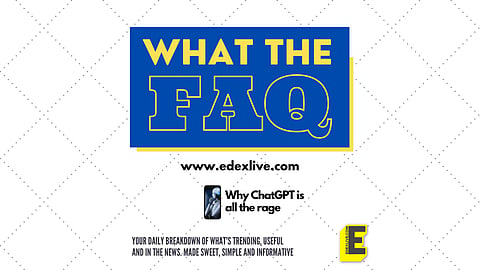

ChatGPT is the talk of the town right now. It all started in November when Professor Ethan Mollick at the University of Pennsylvania asked his students to produce an essay through an Artificial Intelligence model called GPT. These essays not only passed plagiarism tests but were also coherent. This is the model on which ChatGPT is based. ChatGPT was developed as a "research project" by OpenAI which is an AI research lab founded by Elon Musk.
So how does ChatGPT work, and why has it garnered so much interest? We take a look.
What is ChatGPT?
One of the major developments in AI in the last couple of decades has been the emergence of large language models that are trained on massive datasets. ChatGPT is one such model that can generate human-like responses to text inputs from users. The model essentially analyses these datasets, identifies patterns, and generates responses based on predictions, with remarkable accuracy. Think of the Smart Compose feature on Google that predicts your text as you type. With ChatGPT you can ask questions, or give inputs, and the chatbot replies in a human-like way, giving information, creating stories and poems, writing code, translating text, or even giving you suggestions on home decor.
Who developed ChatGPT?
ChatGPT was developed by OpenAI Inc, which is an AI research lab/institute with Elon Musk as one of the founders. It is a California-based company. ChatGPT is based on the GPT-3.5 large language model.
How can one use ChatGPT?
Getting ChatGPT to work is child's play. One can visit the OpenAI website, sign up, and start using the chatbot. In fact, ChatGTP took only five days to cross the one million users mark. And now, it is also being run through a Twitter account, @ChatGPTBot, where you can send your text inputs through a tweet, tag the account, and have your answers. We got ChatGTP to write us a poem on an idyllic winter's day. Here's what we got:
Winter's chill is in the air
But the sun is shining bright
A gentle breeze is blowing fair
And all is calm and right
The snow is fresh and pure and white
And sparkles in the light
The trees are dressed in coats of white
A beautiful and snowy sight
The world is hushed and still
As the day begins to fade
And in the distance, on the hill
A lone bird serenades
All is peaceful, all is well
On this idyllic winter's day
A perfect moment to dwell
And simply pause and sway.
Here are some other examples of what the chatbot can do:
What are some of its limitations?
Obviously, ChatGPT is nowhere near being foolproof. All of its responses are based on the datasets that it has been fed. So it has no knowledge of events after 2021 (yet). This also means that the information it shares is not always accurate. And like in one of the examples shared above, writing a haiku can be a real challenge for this piece of AI.
What are some concerns that the chatbot has raised?
A perennial concern with the development of technology is the fear that it will replace humans in the job market. As these models advance, the concern that they might lead to job losses in certain industries persists. However, the bigger question is that of the spread of misinformation, propaganda and the furthering of biases. Even though the chatbot generates human-like responses, experts suggest it might still lack a moral compass. According to an article by Vox, the chatbot can be tricked into sharing advice on carrying out "evil and nefarious" activities, especially if you ask it to write as a piece of fiction. In fact, we asked ChatGPT if it can be used to spread fake news, and this is what it said:
When will it be available for commercial use, and in what form?
As of now, ChatGPT is not available in the form of an application installed on a device. As a large language model, ChatGPT is not an application that is installed on a device or accessed by users in the same way as other software. Even though it is unclear when and in what form it will be available for commercial use, US-based entrepreneur and the co-founder of Cue, Daniel Gross wrote a piece of code on GitHub, which enabled him to integrate the GPT-3.5 software onto an AI-enabled assistant on Whatsapp, allowing him to interact with the bot as one of his friends in his contact list. Gross called this WhatsApp-GPT. Officially, the Application Programming Interface for the software is not yet available.
